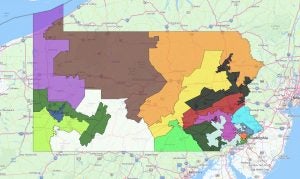GRAPHIC: Pa. Republican leaders propose new congressional map on eve of deadline
UPDATE:
Hours before the state Supreme Court-imposed deadline expired Friday night, Republican legislative leaders submitted drafts of a new congressional map to Governor Tom Wolf.
It was drawn in a frantic two-day period by staff for House Speaker Mike Turzai and Senate President Pro Tempore Joe Scarnati, without input from House or Senate Democrats, or a vote from Pennsylvania’s General Assembly.
Top Senate GOP lawyer Drew Crompton maintained that the court forced Republicans to cut corners, because justices didn’t issue their full opinion until three days before the maps were due.
“I could sit here for ten minutes and criticize the order,” he said. “We complied with the words of the order. We did what we could do in light of us being hamstrung.”
House and Senate Democrats don’t see it that way.
In a letter to Wolf, House Democratic Leader Frank Dermody and his Senate counterpart, Jay Costa, implored him to reject the map outright, arguing the court’s order required the Pennsylvania General Assembly to submit a map, and “the presiding officers [Turzai and Scarnati] are not the General Assembly.”
“The Republican leadership in both chambers blocked this process, refused to negotiate, and have now submitted a map directly to your office that we have not even seen,” they wrote.
A spokesman for the governor agreed that it is unclear whether the Republicans’ submission actually meets the court’s criteria, but said Wolf is still reviewing the map.
The court-dictated timeline called for the legislature to submit a map to Gov. Wolf by Feb 9, giving the governor until Feb 15 to reach consensus with lawmakers. The court said if these deadlines weren’t met, it would draw the map itself — an action Republican leaders say would be an unconstitutional overreach
The court has not weighed in on whether Friday’s actions satisfy its requirement.
The justices’ January 22nd order and subsequent opinion declared the current congressional maps unconstitutionally gerrymandered in favor of Republicans, saying the map deprives voters’ of their right to “free and equal” elections. The Democratic majority bench ruled 5-2 along party lines on the issue.
The court instructed lawmakers to draw new districts “composed of compact and contiguous territory; as nearly equal in population as practicable; and which do not divide any county, city, incorporated town, borough, township, or ward, except where necessary to ensure equality of population.”
On its face, the proposal from GOP leaders does appear to correct the sprawling, winding districts that have been often criticized in the current map.
It would make several infamously convoluted ones—like the Seventh in Southeastern Pa., commonly referred to as “Goofy kicking Donald Duck”—much more compact.
The potential map would also reduce the number of counties split by multiple districts, from 28 to 15. It would split 49 fewer municipalities.
Crompton said mapmakers further took into account something he called the “confusion factor”—how many Pennsylvanians would suddenly find themselves in a totally new district with a new representative.
He said they tried to minimize the number of people displaced, which ultimately resulted in 68.8 percent of people remaining in their original district. They also steered clear of moving any of the 12 congressional incumbents seeking reelection in this year’s midterm election into a different district, avoiding the prospect of an incumbent face-off.
Republican leaders say the submitted map adheres to the Voting Rights Act, and keeps minority populations in the majority in the First and Second Congressional Districts.
But it’s unclear exactly how the proposed map could impact the commonwealth’s partisan breakdown.
Republicans have had a consistent 13-5 majority in the state’s congressional delegation under the current map, which was drawn in 2011 in a process controlled by the GOP.
But Crompton said the map-drawers did not take partisanship into consideration.
“If you ask me the R and D split of that map, I have no idea what it was,” he said. “I can recognize some districts being more competitive than less competitive, but that’s as far as I know.”
Asked which districts might see the biggest changes in competitiveness, he named the Fifteenth and Seventh, currently held by Republicans Charlie Dent and Pat Meehan, neither of whom is running for reelection.
Governor Tom Wolf now has five days to review the map and send a final proposal back to the state Supreme Court.
Turzai and Scarnati have indicated they may be willing to work with him on a compromise plan, and then send it back to the General Assembly to be properly reviewed and voted by all four caucuses.
Wolf could also conceivably reject the Republican map entirely and submit his own to the court.
Republicans said that if the court ends up drawing a map independently of the General Assembly and governor, they intend to bring a case against the justices in federal court—though Crompton called that an avenue of “last resort.”
House and Senate lawmakers remain on call, though Crompton confirmed that the Senate, at least, will not return to session on Monday.
Graphic by Lindsay Lazarski.
WHYY is your source for fact-based, in-depth journalism and information. As a nonprofit organization, we rely on financial support from readers like you. Please give today.






